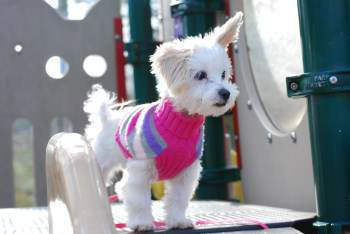Maltipoo Tear Stains
The Causes of Tear Staining
Tear staining can be frustrating to resolve if you do not 1) eliminate the cause and 2) use the right product. Many owners find themselves on a treadmill; working hard but getting no where. Any sort of discoloration under or around the eyes that is red or brown is tear staining; a change in hair color due to various causes. You'll know the difference between stains and natural hair color, because the tear staining will cause the hairs to have a crispy texture that you cannot slide a comb through; the hairs will not be soft as they will be coated with eye discharge and other fluids that have dried onto the hairs.

Beautiful! A clean, pure white Maltipoo with NO tear stains. Maddie, 6 months old
Photo courtesy of Melanie Smith
There are several different causes of Maltipoo tear stains, however whatever the case, there is no reason why the pup or dog need to have a stained coat.
So, let's look at each possible cause and what you, as a concerned owner, can do about it....
Please note:
PetMaltipoo is reader-supported. Some of the product suggestions on this page are affiliate links. As an Amazon Associate we earn from qualifying purchases. This is at no extra cost to you and helps us continue creating useful content.
Excessive Tearing-Tears contain much more than just water. The element to know about in regard to tear stains is porphyrins, which contains iron. If any natural tears spill over the eye and run onto the hairs, the iron in the porphyrins discolors the hairs. The amount of porphyrins in tears varies from dog to dog; this is one reason why some Maltipoo will have tears stains more than others.
In regard to the flow of tears, while some dogs naturally have this more than others, the top reasons for excessive tearing include allergies and irritants. Less common, but possible would be an inverted eyelash, abnormal growth of an eyelid or various eye
diseases. Any chronic excessive tearing warrants a visit to the veterinarian.
Red Yeast
- Whenever an area on a dog stays moist most of the time, that area can easily develop a yeast infection. In the case of tear stains, red yeast can be a culprit. In many cases, using a home remedy of quality tear stain removal products can clear this up. If not, prescribed medications may need to be given.
Teething
- It's very common for puppies that are teething to develop tear stains, since internal passages in the head (eyes, ears, nose, mouth) are all interconnected. While the actual tearing will resolve once the teething phase is complete. staining should be properly removed.
Water and Food Bowls
- What your Maltipoo eats and drinks out of is just as important as what he is ingesting. Plastic bowls - even those that are marketed as being BPA free - can cause quite terrible reactions with dogs. There can be allergic reactions, nose discoloration and tear stains. You'll want to use stainless steel bowls. In addition, if the bowl is too deep, as the Maltipoo dips his head down to drink, hairs on the face can become wet from the water and any moist food. This, in turn, cause the problem of those hairs remaining moist and thus a possible breeding ground for red yeast. So, you'll want appropriately sized, shallow, stainless steel bowls.
Food & Water
- In regard to food, treats can cause staining on a Maltipoo' coat. Many treats that are red, orange or brown are that color because of artificial coloring that is added to it to make it look interesting. Do not be fooled. It would taste the same if it were white. If you have a Maltipoo with tear stains, it is highly suggested to only feed white and light colored (cream, very light tan) manufactured treats....And if feeding a dry manufactured dog food, the same applies. Wet food often does not have coloring added, but it is recommended to read the label.
In regard to water, if the iron content of your tap water is high, it can cause Maltipoo tear staining. Since tap water can legally contain literally hundreds of toxins that can cause health issues when ingested long term, it is highly recommended to offer filtered water. A good option is to connect a filter to the kitchen sink and another option is to obtain a pet watering fountain with a charcoal filter that recycles water to trap small microbes and filter out excess minerals.
At Home Treatments and Remedies for Tear Stains
Making changed as listed above will help prevent staining, however you will need to choose a method to remove existing stains. There are many home remedies listed with various sources, however some do not work and others can cause injury to the eyes.
What does not work:
Boric acid - A solution mix of boric acid and corn starch is often proclaimed as a cure. However if this solution is ingested, even in small quantities, it is harmful to the stomach. There is more risk if you have more than one dog, as the second could lick the face of the first.
Vinegar or lemon extract - Adding one of these to drinking water is often suggested by many sources, however we have found in our experience that most Maltipoo puppies and dogs do not like the taste and will be reluctant to drink as needed.
Powders - Cornstarch and other powders have been rumored to help, however cornstarch is not recommended...This is because it can cause irritation to the dog's eyes, thus causing more tears, which causes wet hairs, which causes bacterial infection...and the cycle begins all over again.
What does work:
Quality canine tear stain wipes. Take care in choosing your product. Some top sellers contain bleach and other ingredients that either can cause irritation or that draw out the coloring of the hairs but do not remove the bacteria that has caused the problem.
Look for a product that:
- Uses organic ingredients to combat both bacteria and fungus
- Does not contain bleach
- Does not contain alcohol (which can really dry out the hair)
- Is not an irritant to the eyes
- Is easy to apply
We list several top choices with full reviews in the Maltipoo Special Shoppe
under 'Grooming'. And no matter which product you use, use it consistently, wiping the eye area twice per day as part of your normal routine with your Maltipoo.
You may Also Like:
Maltipoo Coat Color Changes
- This is an informative article with lots of photos, showing how drastically the coat can change as a Maltipoo matures.

